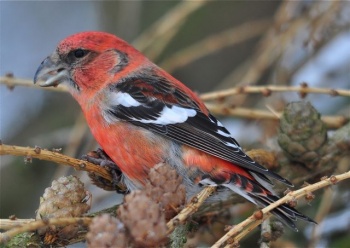Alternative name: Two-barred Crossbill
- Loxia leucoptera
Identification
Length 14.5-17 cm (5¾-6¾ in), weight 25-40 g
Male
- Rich carmine red inclining to crimson or pinkish head and body
- Dark reddish-brown feet
- Blackish primary feathers and tail
- Two broad pure white wing bars
- Tertials with clearly defined pure white tips
Female
- Dusky upper parts
- Yellowish-grey under parts streaked and dusky
- Wings and tail similar to male, but paler
Immature
Resembles female, but under parts are dull yellowish grey, spotted and streaked in dark brown
Similar species
Other crossbills differ in lacking white wingbars, though Red Crossbill (or possibly hybrids between Red and White-winged Crossbills) can show narrow, weak white wingbars with diffuse margins; in pure White-winged Crossbills the wingbars are obvious, broad, and with sharply defined edges. Some other finches with white wingbars such as Chaffinch and Long-tailed Rosefinch could be confused on a brief view, but differ greatly in behaviour and calls.
Distribution
Circumpolar northern hemisphere. The nominate subspecies breeds in northern North America from Alaska to eastern Canada and northern USA, while the subspecies L. l. bifasciata breeds in northern Europe and Asia. Winters a little farther south; irruptive after cone crop failures and can then be seen much further south than the normal wintering areas.
Taxonomy
Subspecies
There are two subspecies[1]:
- L. l. leucoptera (White-winged Crossbill):
- Coniferous forests of north-central Alaska to Newfoundland, Canada and northern US. Marginally smaller and thinner-billed; base of contour feathers darker than tips.
- L. l. bifasciata (Two-barred Crossbill):
- Larch forests of northern Eurasia. Marginally larger and thicker-billed; base of contour feathers same colour as tips.
It has been suggested that the two may be better treated as separate species, but this has not found significant acceptance.
Hispaniola Crossbill was formerly considered to be a third subspecies, but is now treated separately.
Habitat
Mixed conifer forests in northern North America; exclusively in larch forests in northern Eurasia.
Behaviour
This is one of several species of Crossbills and other birds that exhibit irruptive behaviour: they may be resident for several years in a breeding area but are then induced by unfavourable environmental factors to migrate in numbers to areas in which they otherwise are absent.
Diet
Conifer seeds, extracted from cones using their bill adapted for prying. White-winged Crossbill utilises a range of genera, including larch Larix, spruce Picea, hemlock Tsuga, douglas-fir Pseudotsuga and pine Pinus, while Two-barred Crossbill almost exclusively uses larch Larix, rarely using any other conifers.
Vocalisation
White-winged Crossbill
Sólbrekka, Iceland, 15 November 2017
Recording by Falk65
White-winged Crossbill, Trumpet call
Sólbrekka, Iceland, 15 November 2017
Recording by Falk65
References
- Clements, J. F., T. S. Schulenberg, M. J. Iliff, D. Roberson, T. A. Fredericks, B. L. Sullivan, and C. L. Wood. 2018. The eBird/Clements checklist of birds of the world: v2018. Downloaded from http://www.birds.cornell.edu/clementschecklist/download/
Recommended Citation
- BirdForum Opus contributors. (2024) White-winged Crossbill. In: BirdForum, the forum for wild birds and birding. Retrieved 26 April 2024 from https://www.birdforum.net/opus/White-winged_Crossbill
External Links
Search the Gallery using the scientific name:
Search the Gallery using White-winged Crossbill:
Search the Gallery using Two-barred Crossbill:
GSearch checked for 2020 platform.







